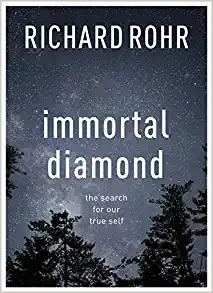This week are continuing with our discussion of Richard Rohr’s book: The Immortal Diamond: The Search for Our True Self. We will be looking at Chapter 3 “What Dies and Who Lives?” and Chapter 4 “The Knife Edge of Experience.” I have found Rohr’s book to be a great compliment to our Lenten discussions on Ecclesiastes.
The central message of Ecclesiastes is that we all die so life is ultimately meaningless. See, Eccl. 2:16-17, 3:19. In Chapter 3, Rohr agrees. The central message of this chapter is that the False Self will necessarily die (the “What Dies” part of the chapter’s title) and therefore the False Self is ultimately meaningless. If you remember our readings in Ecclesiastes, the Speaker only spoke about the things of the False Self. For the Speaker, life was about pursuing earthly wisdom or bodily pleasure. Life consists of amassing wealth or power. When you die, the meaning of these things dies as well. But as we have read in the early parts of Rohr’s book, these things belong to the False Self. And as Rohr teaches in Chapter 3, these things will die and should die.
One topic that Rohr returns to in Chapter 3 is the role of religion. In Chapter 1, Rohr says that “Religion’s job is purely and simply one thing: to tell us and keep reminding us who we objectively are.” p.11. This is what the liturgy of the church (Anglican, Roman, Eastern), and particularly the Eucharistic Rites, is intended to do. Last week in Chapter 2, Rohr writes how Religion can be used to protect the false self by the “diversionary tactics” of becoming moralistic and self-righteously sacrificial. pp. 39-42. In Chapter 3, Rohr says that “If your religion does not transform your consciousness to one of compassion, it is more of a problem than a solution.” A non-transformational religion is the diversionary religion of the False Self. We see Jesus continuously calling out the False-Self religion of the Pharisees, particularly in the parable of the Publican and the Pharisee (Luke 18:9-14) or in his denunciation of the scribes (Matt. 23). It’s what Paul means when he says that that written code of the Law brings death, but the Spirit gives life. 2 Cor. 3:6. In Paul we also find what the transformed life looks like: the Fruit of the Spirit (Gal. 5:23), a New Life (Col. 3:12-17, 1 Thess. 5:13b-18), or a Oneness and Love for each other (Rom. 14, 1 Cor. 12-13). It is this True Self of a transformed life that lives. 1 Cor. 15:52.
On a side note, I was sent This Article (Experimental Philosophy and the Notion of the Self by Joshua Knobe) concerning an experimental philosopher’s investigation of the true self, or at least people’s perception and understanding of their true selves. What the writer found is that most people “think that the true self is whichever part of you is morally good.” If you have this weekend, I encourage you to read the article and see how it fits in with Rohr’s book.
Dinner is at 6. The menu is Cajun-style chicken fricassee. Discussion about 6:45. Hope to see you here. Please bring a friend.
Put on then, as God’s chosen ones, holy and beloved, compassion, kindness, lowliness, meekness, and patience, forbearing one another and, if one has a complaint against another, forgiving each other; as the Lord has forgiven you, so you also must forgive. And above all these put on love, which binds everything together in perfect harmony.
Colossians 3:12-14

